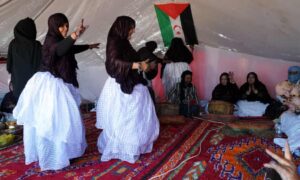
From the outside, Asria Mohamed’s tent in a refugee camp in south-west Algeria could be mistaken for a typical four-door nomadic dwelling used by Sahrawis, people from Western Sahara, though it is smaller in size.
Inside, however, is a series of QR codes attached to 19 melhfas, traditional clothing worn by Sahrawi women, that have been stitched to the tent’s interior walls, forming a colourful tapestry. Visitors are invited to scan the QR codes to dive into the stories of the women behind each melhfa.
Jaimitna (Our Tent) is a collaborative artistic project, led by Mohamed, to highlight the plight of Sahrawis and their homeland on the north-west coast of Africa, which has been occupied by Morocco since 1976, when Spain’s rule over its last foreign territory ended, in what is known as “the last colony in Africa”.
“You approach Jaimitna and it’s made of a colourful fabric, and you think ‘oh, it’s so beautiful.’ But then when you scan the QR codes you will get the stories of horror,” Mohamed says.
“I asked 19 woman human rights defenders from the occupied territory to send me their melhfas,” she says.
“One of the women, Zainabu Babi, actually sent me a bloodstained melhfa from when she was beaten up during a protest.”
Hand-sewn by two women from the refugee camps, Jaimitna was at the centre of the Sahara international film festival, FiSahara, held earlier this month at the Ausserd camp in Algeria. The theme of this year’s festival was Jaimitna Fi Cinema (Our tent in the cinema): To Resist is to Win.
